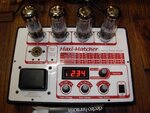danny davis
Banned

The Digital tube tester , test the tubes at high voltage at 300 volts to 400 volts VS Analog Tube testers, test the preamp or power amp tubes at lower voltages?
Testing Tubes on an analog tube tester will PASS the test because the analog tube tester is testing them at a low voltage. But you slap those tubes that have passed the test and they will fail in the preamp or power amp because now they are in a 400 volt circuit.
Why do they fail with high voltage but now with low voltage?
Analog Tube testing , doesn't test the preamp or power amp tubes for Noise or Hum? but does a digital tube tester test the tubes for hum and noise?
The Digital tube tester , test the Plate current and Transconductance of a power tube, which analog tube tester don't?
Does an Analog tube tester, test the Transconductance of a preamp or power tube? I don't remember see a function on my analog tube tester
Power Tube Digital Tester:
**broken link removed**
Pre-Amp Tube Digital Tester:
**broken link removed**
Listen to your tubes with dual-RCA Direct Audio Output? is this to test for the NOISE of the preamp tubes?
Testing Tubes on an analog tube tester will PASS the test because the analog tube tester is testing them at a low voltage. But you slap those tubes that have passed the test and they will fail in the preamp or power amp because now they are in a 400 volt circuit.
Why do they fail with high voltage but now with low voltage?
Analog Tube testing , doesn't test the preamp or power amp tubes for Noise or Hum? but does a digital tube tester test the tubes for hum and noise?
The Digital tube tester , test the Plate current and Transconductance of a power tube, which analog tube tester don't?
Does an Analog tube tester, test the Transconductance of a preamp or power tube? I don't remember see a function on my analog tube tester
Power Tube Digital Tester:
**broken link removed**
Pre-Amp Tube Digital Tester:
**broken link removed**
Listen to your tubes with dual-RCA Direct Audio Output? is this to test for the NOISE of the preamp tubes?

